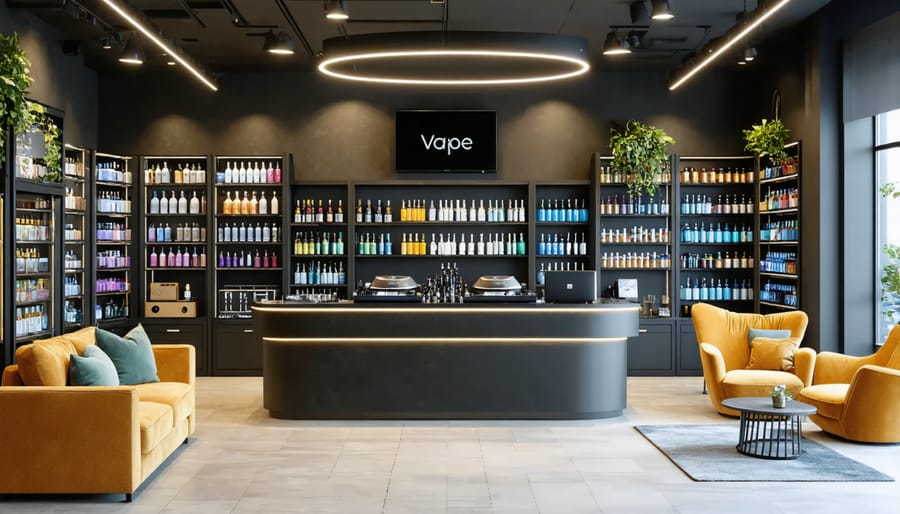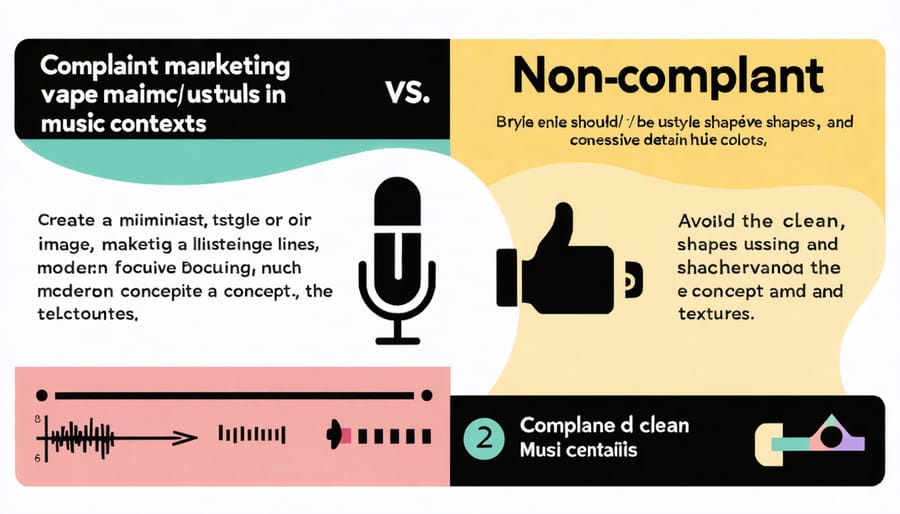The convergence of vaping culture and music industry marketing has fundamentally transformed both sectors, with partnerships between top-rated vape store brands and recording artists generating unprecedented promotional opportunities. From festival sponsorships to music video product placements, this strategic alliance represents a multi-billion dollar intersection of lifestyle marketing and artistic expression. As regulatory frameworks evolve across North America, particularly in Canada’s distinct legal landscape, these collaborations continue reshaping how audiences engage with both music and vaping products.
The integration extends beyond mere commercial partnerships, influencing artistic content, concert experiences, and social media engagement strategies. Major record labels increasingly incorporate vaping lifestyle elements into their artists’ brand identities, while vape manufacturers align their marketing narratives with specific music genres and cultural movements. This symbiotic relationship, though controversial, demonstrates the powerful potential of cross-industry collaboration in shaping contemporary youth culture and consumer behavior.
Understanding these connections provides crucial insights for industry professionals navigating this complex landscape, where creative expression meets commercial interest, and regulatory compliance intersects with cultural influence.
The Evolution of Vape Store Music Partnerships
From Background Music to Brand Identity
Vape retailers have increasingly recognized music’s power to shape customer experience and strengthen brand identity. These establishments carefully curate playlists that reflect their target demographic while creating an immersive atmosphere that encourages longer store visits and repeat customers. Many shops partner with music licensing services to ensure legal compliance while accessing extensive libraries of contemporary and genre-specific tracks.
The musical ambiance in vape stores often blends electronic, indie, and alternative genres, creating a modern urban feel that resonates with their predominantly younger clientele. Some retailers have developed signature playlists that customers can follow on streaming platforms, extending the brand experience beyond physical locations and building community through shared musical taste.
Canadian vape retailers particularly excel at incorporating local artists into their store soundtracks, supporting homegrown talent while establishing authentic connections with their communities. This musical curation has become so integral to the vaping retail experience that some chains now employ dedicated music directors to maintain consistent atmospheric branding across multiple locations, demonstrating music’s evolution from background element to essential brand component.

Local Artist Showcases in Vape Retail
Vape retailers across Canada are increasingly embracing their role as cultural hubs, creating unique spaces where music and community converge. Following the tradition of record stores and coffee shops, these establishments have begun hosting intimate live performances, particularly during summer music festivals and local events. This innovative approach to local music promotion has created valuable opportunities for emerging artists to connect with diverse audiences.
Many vape shops now feature dedicated performance areas, complete with basic sound systems and lighting, transforming their retail spaces into impromptu venues during evening hours. These establishments often collaborate with local music collectives and independent artists, offering them a platform to showcase their talents while attracting a steady stream of customers who appreciate both the products and the cultural experience.
The symbiotic relationship between vape retailers and musicians has led to creative partnerships, including exclusive merchandise collaborations and cross-promotional opportunities that benefit both parties while fostering a stronger sense of community engagement.
Music Industry’s Embrace of Vape Culture
Artist Endorsements and Collaborations
The intersection of vape culture and music has led to numerous high-profile partnerships, particularly evident at Canadian live events and international music festivals. Notable artists like DJ Khaled and The Weeknd have entered into promotional agreements with leading vape brands, leveraging their influence to reach younger demographics while adhering to regulatory guidelines.
These collaborations often manifest through exclusive product lines, limited-edition devices, and custom-branded merchandise. Musicians frequently integrate vape-related imagery into their music videos and social media presence, though this practice has faced increasing scrutiny from health advocates and regulatory bodies.
In the Canadian market, partnerships tend to be more subtle due to stricter advertising regulations. Artists typically engage through sponsored performance venues and age-restricted brand activations rather than direct product endorsements. This approach allows for maintaining artistic integrity while complying with federal marketing restrictions.
International artists have found creative ways to participate in the vape industry, from equity partnerships to signature flavor development. However, these relationships are evolving as the industry faces new challenges and regulations. Many artists now emphasize harm reduction and responsible use in their messaging, reflecting a shift toward more conscientious brand partnerships.
Industry experts predict future collaborations will focus more on technology innovation and sustainable practices, moving away from traditional celebrity endorsement models.

Music Video Integration
The integration of vaping products and imagery into music videos has become increasingly prevalent across multiple genres, reflecting the evolving relationship between consumer culture and musical expression. Notable artists from hip-hop, pop, and electronic music scenes have incorporated vaping elements into their visual narratives, either through product placement or as aesthetic choices that align with contemporary youth culture.
Industry data suggests that music videos featuring vaping content receive significant engagement on streaming platforms, particularly among viewers aged 18-34. This phenomenon has led to both organic and sponsored inclusions, with major vape brands actively seeking partnerships with music video productions. In the Canadian market, these collaborations must navigate strict regulatory frameworks while maintaining artistic integrity.
The visual representation of vaping in music videos often employs specific cinematographic techniques, such as slow-motion vapor trails and atmospheric lighting, creating compelling aesthetic elements that enhance the overall production value. However, this artistic choice has sparked discussions about responsibility and influence, particularly regarding youth audiences.
Music video directors and producers increasingly find themselves balancing artistic vision with ethical considerations and compliance requirements. Some artists have begun incorporating anti-smoking messages or health disclaimers in their content, demonstrating awareness of their platform’s influence while maintaining creative expression.
As streaming platforms evolate their content policies, the future of vaping imagery in music videos may face new challenges and opportunities for creative interpretation.
Legal and Ethical Considerations

Canadian Marketing Regulations
In Canada, vape marketing within the music industry faces strict regulatory oversight under the Tobacco and Vaping Products Act (TVPA). These regulations significantly impact how vape companies can engage with music events, festivals, and artist partnerships. Promoters and organizers must navigate complex event marketing regulations that prohibit lifestyle advertising and restrict promotional activities targeting young adults.
Key restrictions include the prohibition of testimonials, lifestyle advertising, and sponsorship activities that associate vaping with positive lifestyle imagery. Music venues and festival organizers must ensure compliance by avoiding vape product displays, branded merchandise, or promotional materials that could appeal to youth or non-smokers.
The regulations specifically address digital marketing, requiring age verification for online content and limiting social media engagement. This affects how artists and music industry professionals can collaborate with vape brands, particularly in content creation and social media partnerships.
Penalties for non-compliance are substantial, including fines up to $500,000 for corporations and potential criminal charges for serious violations. Industry stakeholders must maintain detailed documentation of marketing activities and ensure all promotional materials receive appropriate regulatory approval before implementation.
These stringent measures aim to balance commercial interests with public health concerns while maintaining the integrity of both the music and vaping industries.
Balancing Promotion and Responsibility
The intersection of music and vape marketing presents complex ethical considerations that industry professionals must carefully navigate. While promotional partnerships can offer valuable revenue streams for artists and venues, particularly in an era of declining traditional music sales, these collaborations require thoughtful implementation to maintain artistic integrity and social responsibility.
Music industry stakeholders must consider the potential impact on younger audiences, who are often the most engaged with music culture. This necessitates clear age verification protocols and responsible marketing practices that align with both legal requirements and ethical standards. Artists and promoters should evaluate whether vape partnerships align with their brand values and social responsibility commitments.
Canadian artists and industry professionals face additional considerations due to specific regulatory frameworks governing both vape products and entertainment marketing. Successful partnerships often incorporate harm reduction messaging and educational components, demonstrating a commitment to community wellbeing alongside commercial interests.
Some industry leaders have adopted balanced approaches, such as limiting vape marketing to age-restricted areas at venues and events, or focusing promotional content on harm reduction for existing smokers. These strategies help maintain promotional opportunities while addressing public health concerns and regulatory compliance.
Moving forward, the industry must continue developing frameworks that balance commercial opportunities with social responsibility, ensuring that music-vape partnerships contribute positively to both sectors while protecting vulnerable audiences.
Future Trends and Opportunities
As the landscape of music industry partnerships continues to evolve, several emerging trends suggest new directions for vape-music collaborations. Market analysts predict a shift toward more sophisticated, lifestyle-oriented partnerships that extend beyond traditional product placement and merchandise deals.
Virtual concerts and digital experiences are becoming increasingly significant platforms for brand integration. With the rise of metaverse technologies, vape brands are exploring opportunities to create immersive musical experiences and virtual merchandise, reaching audiences in innovative ways while navigating promotional restrictions in physical spaces.
Sustainability initiatives are gaining prominence, with both industries facing pressure to address environmental concerns. Forward-thinking collaborations are focusing on eco-friendly packaging, recyclable materials, and carbon-neutral event partnerships. This alignment with environmental consciousness resonates particularly well with younger audience demographics.
The Canadian market presents unique opportunities for growth, especially as regulations continue to evolve. Industry experts anticipate more sophisticated cross-border partnerships, with Canadian artists and vape brands potentially leading the way in responsible marketing practices that could become global standards.
Data-driven partnerships are emerging as a key trend, with brands utilizing streaming metrics and social media analytics to forge more targeted and effective collaborations. This approach allows for better audience segmentation and more personalized marketing strategies while ensuring compliance with regional regulations.
Looking ahead, we may see the development of exclusive artist-branded product lines that emphasize wellness and harm reduction, moving away from purely lifestyle-focused marketing. This shift could include collaborations with health awareness campaigns and educational initiatives.
The integration of blockchain technology and NFTs presents new possibilities for authentic merchandise verification and exclusive content distribution, potentially revolutionizing how these partnerships are structured and monetized.
These evolving trends suggest a future where vape-music industry collaborations become more sophisticated, responsible, and technologically integrated, while maintaining strong connections to artistic authenticity and cultural relevance.
The convergence of vape culture and the music industry has created a complex ecosystem of marketing opportunities, creative collaborations, and evolving business models. As we’ve explored throughout this analysis, these connections have significant implications for both sectors, particularly in the Canadian market and beyond. The relationship between vaping brands and music continues to evolve, shaped by regulatory frameworks, changing consumer preferences, and cultural shifts.
Looking ahead, we can expect to see more sophisticated partnerships emerging, with an emphasis on digital platforms and virtual experiences. The music industry’s adaptation to new marketing channels and revenue streams suggests that collaboration with lifestyle brands, including vape companies, will remain important. However, these partnerships will likely become more nuanced and socially conscious, responding to public health concerns and regulatory requirements.
The future outlook indicates a shift toward more sustainable and responsible marketing practices, with both industries potentially exploring innovative ways to engage audiences while adhering to ethical guidelines. As digital transformation continues to reshape both sectors, we may see the emergence of new collaborative models that prioritize artist authenticity and consumer well-being.
For stakeholders in both industries, success will depend on their ability to navigate this changing landscape while maintaining creative integrity and social responsibility. The key will be finding balance between commercial opportunities and ethical considerations, ensuring that partnerships add value to both the music and vaping communities while respecting regulatory boundaries.
